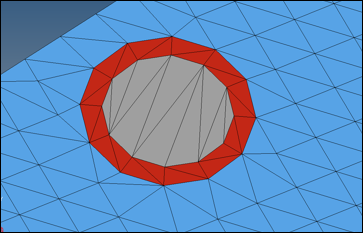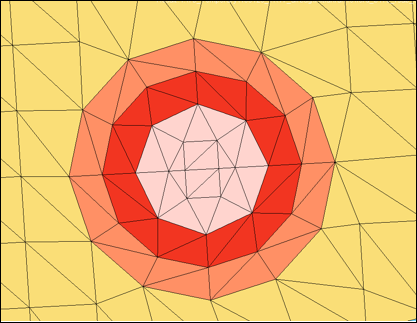Vent Holes
Each vent hole should be represented as a separate component in the same position as in the CAD geometry.
The vent hole is modeled using a void material and property. All nodes of the void vent components should be connected to a fabric component. Density, Young’s modulus and thickness should be defined for the void components using the same values as the fabric material of the airbag. These values are important for the contact defined between void components which helps to maintain the internal airbag volumes.
#---1----|----2----|----3----|----4----|----5----|----6----|----7----|----8----|----9----|---10----|
/MAT/VOID/2
Material void
# RHO E
8E-7 0.38
#---1----|----2----|----3----|----4----|----5----|----6----|----7----|----8----|----9----|---10----|
/PROP/VOID/2
Property void
# Thick
0.3
#---1----|----2----|----3----|----4----|----5----|----6----|----7----|----8----|----9----|---10----|

Figure 1. Blue- Airbag Fabric; Grey- Vent Hole; Red - Component That Separates Vent Hole from Rest of Airbag
/MONVOL/FVMBAG1
……….
# Sid_vent Ivent Avent Bvent
666000015 1 1 0
# Tstart Tstop dPdef dtPdef Idtpdef
1E30 0 1E-06 0 0
# fct_IDt fct_IDP fct_IDA Fscalet FscaleP FscaleA
0 123 0 0 0 0
# fct_IDt' fct_IDP' fct_IDA' Fscalet' FscaleP' FscaleA'
0 0 0 0 0 0
………
/FUNCT/123
1 vent area scaling function
# X Y
-1 0
0 0
1e-06 0
2e-06 1
1 1The vent hole can be activated at Tstart or when the overpressure defined by is reached. To use only Tstart define a large value. To use only define a large Tstart value. If using it is recommended to use 1e-06GPa (1% atmospheric pressure).
ELEM: 46991 <-> SH3N : 55089506 - VENT HOLE: 1
ELEM: 46992 <-> SH3N : 55089507 - VENT HOLE: 1
ELEM: 46993 <-> SH3N : 55089508 - VENT HOLE: 1
ELEM: 46994 <-> SH3N : 55089509 - VENT HOLE: 1
ELEM: 46995 <-> SH3N : 55089510 - VENT HOLE: 1
ELEM: 46996 <-> SH3N : 55089511 - VENT HOLE: 1
ELEM: 46997 <-> SH3N : 55089512 - VENT HOLE: 1

Figure 2. Vent Hole with Variable Diameter


Figure 3. Slit Vent Modeling